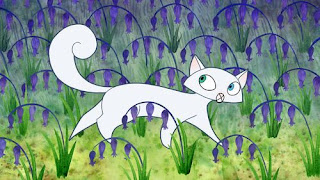I want to go to Kells.
After learning about the Book of Kells
and especially after watching The Secret of Kells,
I am pretty much enchanted.
(Ignore the cliché, if you will).
I loved this film because it literally brought to life many of the things we had been discussing in class. I felt like the filmmakers did an incredible job of honoring the traditions of Kells.
Not only did they include Christian religious themes but they also incorporated several pagan themes, which I thought created a really intriguing element. It was lovely.
My favorite part was the illustration.
The film was obviously paying tribute to the exquisitely beautiful illustrations found in the old insular manuscripts (like the book of Kells). They pulled it off, while updating the style to make it current and approachable.
Another interesting fact that I discovered while researching this film (because yes, I did find it on Netflix and I did finish it and thoroughly enjoyed every last bit) was the background on the little kitty called Pangur Bán. Pretty interesting name? Yes, actually. Turns out that "Pangur Bán" is the name of an ancient poem written in around the 9th century by an Irish monk. The poem is about a cat, named Pangur Bán, of course, which translates as "white fuller." The anonymous poet uses the descriptions of his cat's daily routine as a metaphor for his own life. Interesting! I love finding little tidbits of information like this. Almost as much as I love little white kitties.










